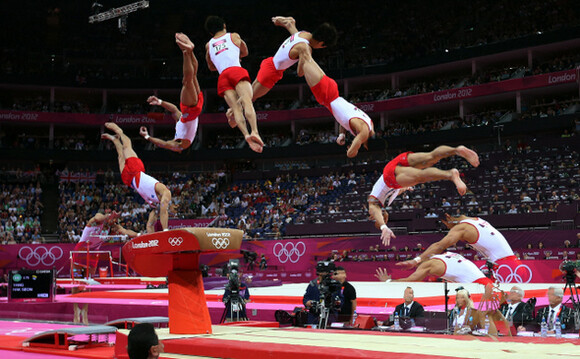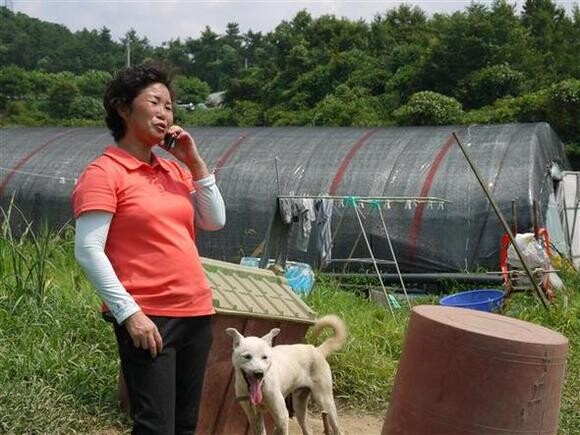hankyoreh
Links to other country sites 다른 나라 사이트 링크
Yang Hak-seon vaults from poor beginnings

By Kim Yang-hee, staff reporter
The nineteen-year-old seemed trepidacious. His Kakao Talk profile read, “Yang! Hak! Seon! Shoooow your coooourage!!!!!” Such was the urgency. A few days before, he had dreamed of being shunned by his cohorts at the Taereung Athletes’ Village, national training center for South Korean athletes, for failing to win a medal. Even the springboard at North Greenwich Arena was causing problems: the springs were too strong for his body weight. Chances of gold? Ninety-nine percent. And even that was just a possibility. Nobody could say for certain. But the Korea National Sport University student was as courageous as he had to be on the Olympic stage. More than that: he was flawless.
Yang started gymnastics as a second grader at Gwangcheon Elementary School in Gwangju. He had older friends on the school’s gymnastics team who would look after him while his parents were at work. He excelled early on with the parallel bars and rings, but as he moved on to Gwangju Physical Education Middle and High School, the vault became his specialty.
“His talent wasn’t immediately obvious or anything like that,” recalled Oh Sang-bong, the coach at the school, in a telephone interview on August 7 with the Hankyoreh. “Over a few years, it became apparent what event he would do well at [the vault]. As a junior, he was already practicing senior-level technique.”
Adolescence brought its fair share of trials. Pressed by his family’s struggles in a poor community on one hand and arduous daily training on the other, he began hanging out with older kids from the neighborhood, and ran away a few times. Each time, Oh and his mother found him. “One day, his mother came to school and said, ‘Hak-seon is no longer my son now. Do with him what you will,’” the coach said. “At that point, I told him, ‘With the circumstances you face, what can you do best besides gymnastics?’”
As a ninth grader, Yang pulled off a Yeo 2. This maneuver, first performed at the 1996 Atlanta Games by South Korea’s Yeo Hong-chul (now a professor at Kyung Hee University), involves pushing on the vault with two hands and doing two-and-a-half somersaults in the air, landing facing the vault (difficulty level 7.0). He was a quick study, succeeding after just a few attempts.
During the second round of vault qualifying in London on August 6, he received 9.600 out of ten with a triple Tsukahara (difficulty level 7.0), which involves approaching the vault with a sideways twist and doing three turns in midair. This, too, was something he nailed down in high school. He performed both of these maneuvers in his gold medal-winning vault performance at the 2010 Asian Games in Guangzhou.
But a 7.0 difficulty level wouldn’t be enough to make him the world’s best. He needed to learn maneuvers at a 7.2 level or higher. Despite his relatively diminutive build (159 cm in height, 51 kg in weight), Yang has taken full advantage of his outstanding torque, a product of nearly flawless balance in his body. This was the origin of his own move, the Yang Hak-seon: pushing off with two hands and doing three twists (1080 degrees) in midair, landing facing away from the vault.
“They told me that technique is something you feel with your body, and when I first did that, I thought, ‘This is my technique,’” Yang recalled.
The maneuver, which Yang performed once at the 2011 World Championships in Tokyo and then again in London, had foreign media like the Associated Press and Reuters praising it as something only he could pull off. That he still earned over nine points (9.066) despite taking two full steps on the landing was a testament to the unequaled level of difficulty. Players and coaches from the Russian and US teams asked to shake his hand after the qualifying, calling him the “vault god.”
Yang is still a sensitive young man. He cries every time he watches the Japanese anime series “Anohana: The Flower We Saw That Day,” and his favorite songs are ballads. But standing before the vault turns his nerves to steel.
“Hak-seon hasn’t appeared in a lot of international competitions, so he’s short on experience, but he’s been very strong when things get competitive,” said Oh. “I think he likes competing.”
Song Joo-ho of the Korea Institute of Sport Science said Yang has “star quality. He’s not at all camera-shy.”
Having earned South Korea its first ever gymnastics gold, Yang is now entitled to 160 million won (US$141,700) in prize money: 60 million from the government, and another 100 million from the Korea Gymnastic Association. And that‘s not all: according to Yonhap News, the SM Group plans to give him and his family a 116m2 apartment that is currently being built in Gwangju’s South district, with a scheduled completion date late next year. It is the realization of his dream, which he once said was to “win gold and build a house for my parents, who live in a vinyl greenhouse.”

Yang has already been helping his parents out with 800,000 won (US$709) a month from his savings, which include prize money from the Asian Games in Guangzhou and the 40,000 won (US$35) in daily training expenses from the Taereung Athletes‘ Village.
This is far from the end of the road. Yang is still only nineteen. He can certainly compete in the 2016 and 2020 games.
The gymnast himself has big plans: “I want to develop a new move that adds one more half-twist to the Yang Hak-seon.” That would take his movement from 1080 to 1260 degrees.
Oh said, “He needs more height and power if he’s going to perfect the ‘Yang 2,’ but with his gifts, he should be able to do that.
”He may be able to win two Grand Slams,“ he added, referring to the Olympics, World Championships, Asian Games, and Asian Championships.
Please direct questions or comments to [english@hani.co.kr]

Editorial・opinion
![[Editorial] Does Yoon think the Korean public is wrong? [Editorial] Does Yoon think the Korean public is wrong?](https://flexible.img.hani.co.kr/flexible/normal/500/300/imgdb/original/2024/0417/8517133419684774.jpg) [Editorial] Does Yoon think the Korean public is wrong?
[Editorial] Does Yoon think the Korean public is wrong?![[Editorial] As it bolsters its alliance with US, Japan must be accountable for past [Editorial] As it bolsters its alliance with US, Japan must be accountable for past](https://flexible.img.hani.co.kr/flexible/normal/500/300/imgdb/original/2024/0417/6817133413968321.jpg) [Editorial] As it bolsters its alliance with US, Japan must be accountable for past
[Editorial] As it bolsters its alliance with US, Japan must be accountable for past- [Guest essay] Amending the Constitution is Yoon’s key to leaving office in public’s good graces
- [Editorial] 10 years on, lessons of Sewol tragedy must never be forgotten
- [Column] A death blow to Korea’s prosecutor politics
- [Correspondent’s column] The US and the end of Japanese pacifism
- [Guest essay] How Korea turned its trainee doctors into monsters
- [Guest essay] As someone who helped forge Seoul-Moscow ties, their status today troubles me
- [Editorial] Koreans sent a loud and clear message to Yoon
- [Column] In Korea’s midterm elections, it’s time for accountability
Most viewed articles
- 1[Column] The clock is ticking for Korea’s first lady
- 2Samsung barricades office as unionized workers strike for better conditions
- 3[Editorial] When the choice is kids or career, Korea will never overcome birth rate woes
- 4[News analysis] After elections, prosecutorial reform will likely make legislative agenda
- 5S. Korea, Japan reaffirm commitment to strengthening trilateral ties with US
- 6Japan officially says compensation of Korean forced laborers isn’t its responsibility
- 7Why Israel isn’t hitting Iran with immediate retaliation
- 8[Editorial] Does Yoon think the Korean public is wrong?
- 9[Guest essay] How Korea turned its trainee doctors into monsters
- 10[Guest essay] Amending the Constitution is Yoon’s key to leaving office in public’s good graces